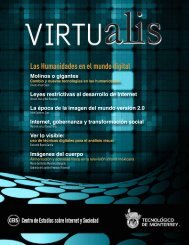P
terranova-network-culture
terranova-network-culture
- No tags were found...
You also want an ePaper? Increase the reach of your titles
YUMPU automatically turns print PDFs into web optimized ePapers that Google loves.
Three Propositions on Informational Cultures 11(in its positivistic, ‘social physics’ version). A rigorous mathematicaltheory of information, however, was developed only in the 1940sby members of the cybernetic group and by engineers at AT&T’s BellLaboratories (and in particular by R.V.L. Hartley, Harry Nyquist, andClaude E. Shannon). For Jérôme Segal, the milieu of communicationengineers working in corporate labs in the United States wasparticularly rife for such technical and scientific breakthroughs. Onthe one hand, the US engineers did not share the narrow vocationalfocus that kept their European peers within the social hierarchy of atheory/practice divide. North American telecommunication engineershad been trained in physics departments (for example, on MIT’sElectrical Engineering course) and had thus a good knowledge of themost abstract and complex physics debates. 4On the other hand, US communication engineers were alsoconfronted by complex problems of speed and accuracy in signalstransmission posed by the large telecommunication networks ofthe United States, where signals had to be repeatedly relayed beforereaching their destinations. It would also be hard to underestimatethe importance of the internationalization and interdisciplinarizationof science during and immediately after World War II – a process thatprovided the material circumstances for the constitution of a theoryof information linking physics, statistics and telecommunications andthat prepared the ground for the informatization of life in molecularbiology. The concept of information was part of research taking placewithin the field of ‘communication and control engineering’ – abranch of engineering that depended on a larger theory of messagesinvolving the contribution of linguistics and cryptoanalysis to theunderstanding of communication codes. Norbert Wiener went sofar as to argue that the difference between the older field of powerengineering and communication engineering marked a shift from thelong nineteenth century of the industrial society to a new cyberneticage of communication, command, and control. 5Shannon established his reputation as the pivotal point aroundwhich a century of attempts to conceptualize information as aphysical quantity revolved on the basis of a paper on what he called‘the mathematical theory of communication’, published in the BellSystem Technical Journal in 1948. Shannon’s paper advanced a set oftheorems that dealt ‘with the problem of sending messages from oneplace to another quickly, economically, and efficiently’. 6 Shannon’s‘Mathematical Theory of Communication’ was republished by theUniversity of Illinois Press in 1949, together with Warren Weaver’s








